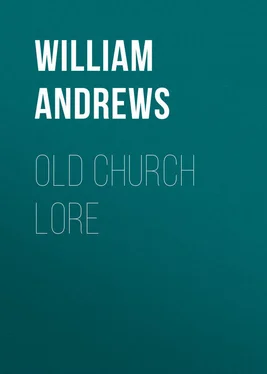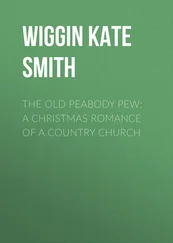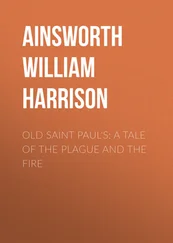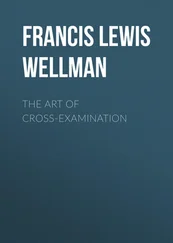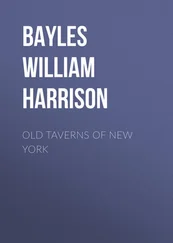William Andrews - Old Church Lore
Здесь есть возможность читать онлайн «William Andrews - Old Church Lore» — ознакомительный отрывок электронной книги совершенно бесплатно, а после прочтения отрывка купить полную версию. В некоторых случаях можно слушать аудио, скачать через торрент в формате fb2 и присутствует краткое содержание. Жанр: foreign_antique, foreign_prose, на английском языке. Описание произведения, (предисловие) а так же отзывы посетителей доступны на портале библиотеки ЛибКат.
- Название:Old Church Lore
- Автор:
- Жанр:
- Год:неизвестен
- ISBN:нет данных
- Рейтинг книги:3 / 5. Голосов: 1
-
Избранное:Добавить в избранное
- Отзывы:
-
Ваша оценка:
- 60
- 1
- 2
- 3
- 4
- 5
Old Church Lore: краткое содержание, описание и аннотация
Предлагаем к чтению аннотацию, описание, краткое содержание или предисловие (зависит от того, что написал сам автор книги «Old Church Lore»). Если вы не нашли необходимую информацию о книге — напишите в комментариях, мы постараемся отыскать её.
Old Church Lore — читать онлайн ознакомительный отрывок
Ниже представлен текст книги, разбитый по страницам. Система сохранения места последней прочитанной страницы, позволяет с удобством читать онлайн бесплатно книгу «Old Church Lore», без необходимости каждый раз заново искать на чём Вы остановились. Поставьте закладку, и сможете в любой момент перейти на страницу, на которой закончили чтение.
Интервал:
Закладка:
William the Conqueror invested the Abbot of Battle Abbey with authority to save the life of any malefactor he might find being executed, and whose life he wished to spare.
Amongst the many privileges enjoyed by the Archbishop of York, was that of having a mint. As early as the year 1070, we find a mention of the mint, and particulars of attempts made, without success, to destroy or curtail His Grace’s coining. Archbishop Lee, who died in 1544, is said to have been the last to exercise the power of issuing money.
In bygone times, the Archbishops of York appear to have enjoyed almost regal power. The baronies of Beverley, Sherburn, Patrington, Otley, and Wilton belonged to them. They appointed justices for these important towns, had prisons, gallows, pillories, and ducking-stools, and did their utmost to maintain law and order.
It will be gathered from the foregoing that prelates were granted privileges which enabled them to exercise much power amongst the people. Some of the rights enjoyed at Hull by the Archbishop of York were oppressive to the inhabitants of the town, and gave rise to much strife. It was the practice, exercised according to ancient custom, of the Archbishop of York to claim prisage from every vessel of twenty tons burden entering the river Hull. Two casks of wine were demanded, one from before and the other from behind the mast. The casks, however, might be redeemed by paying twenty shillings for each cask. The merchants successfully evaded payment of duty by unloading their ships in the Humber, and bringing their goods into port in small craft. As may be readily expected, the Archbishop was much annoyed at the conduct of the men of Hull, who received the support of the Mayor of the town; indeed, if we read history aright, we find the local authorities had a desire to enjoy the privileges claimed by the prelate. A great difficulty had been experienced for a long time by the officers of the Archbishop in collecting the dues, and Archbishop Neville saw that unless he made a firm stand to maintain his privileges, they would be lost. In the year 1378, he decided to visit Hull, and enforce his rights. The Mayor of Hull, at that time was Sir Thomas de Waltham, a knight of quick temper, and with no particular respect for persons with whom he came in contact.
The Archbishop, with a few attendants, numbering less than a dozen, came to the town. The Mayor, accompanied by two bailiffs, named John Arnold and Thomas Green, and a large company of local supporters, met His Grace. The Archbishop complained bitterly to the Mayor, saying, amongst other serious faults, that he had shown himself wanting in that respect for the Archbishop which the representative of religion was entitled to receive. His Worship soon waxed warm, declaring that he had only done his duty in maintaining the rights of his fellow-townsmen. The prelate insisted that the Mayor was in the wrong, and that it was his intention to enforce the payment of his dues. The Mayor soon shewed signs of his displeasure, and seeing one His Grace’s men mocking him, he, without ceremony, snatched from the Archbishop his crosier, and struck the man. This was the commencement of a free fight, in which the prelate and his people suffered a severe defeat. Blood freely flowed, and the Archbishop, seeing that he could not make, with any degree of success, a stand against so many opponents, beat a hasty retreat, followed a considerable distance out of the town by a large number of excited inhabitants of Hull, eager to avenge the wrongs it was believed His Grace had done to the port by collecting, or attempting to collect, prisage. The Mayor, it must be recorded, fought manfully with the crosier, which was broken into several pieces.
The Archbishop, being a Court favourite, brought the matter under the notice of the King. The Mayor was summoned to appear before His Majesty at Westminster. This proceeding doubtless caused much trouble in Hull, but the Mayor, feeling that he had right on his side, proceeded to London with a brave heart, and at the trial pleaded his cause with considerable eloquence. The case resulted in judgment being left in abeyance, or, in other words, His Grace was non-suited.
We can readily imagine that the Mayor would return home in higher spirits than when he left it to appear in the King’s Court, and that he would receive a hearty welcome from his fellow townsmen.
The place where the fight occurred was regarded by the superstitious as sacred, crowds of fanatics repairing to it to shed tears. Not a little inconvenience was caused by their conduct, and their proceedings were stopped by a permanent guard being appointed to keep folk away from the place.
After the death of the Archbishop, it was believed for many years that his spirit haunted the spot where the battle was fought.
In spite of the serious breach between Prelate and Mayor, Hull appears to have been a favourite residence in past times of the Archbishops of York. We know, from the annals of the town, that in the year 1442 the Archbishop had a house in the historic High Street.
Dr. Thomson, the late Archbishop of York, was a frequent and welcome visitor to the town. The last time he was in Hull, His Grace was the guest of Alderman Sherburn, the Mayor. When we saw the two gentlemen in friendly conversation, we could not help contrasting the conditions of 1889 with those of 1378, and noting the great changes which five centuries have brought about, changes better alike for gentle and simple.
Chapels on Bridges
The building of bridges in bygone times was regarded as a religious duty. An order of friars was established on the continent, in the twelfth century, having for its object the erecting and repairing of bridges. Its work extended into several countries. In France, the friars built the celebrated bridge over the Rhone at Avignon, and a bridge, still in use, at Pont St. Esprit, was one of their works. We have not any traces of the operations of the order in England, but there were in the country, prior to the reign of Richard II., lay-brotherhoods performing a similar good work.
Queen Matilda erected and endowed bridges at Stratford and Bow, which she regarded as meritorious. The Church looked upon the work as one deserving of encouragement. Richard de Kellawe, Bishop of Durham, from 1311 to 1316, for example, promised to remit penances for those engaged in bridge-building. The Registry of his Episcopal Chancery contains many entries similar to the following: “Memorandum … his lordship grants forty days’ indulgence to all who will draw from the treasure that God has given them, valuable and charitable aid towards the building and repair of Botyton bridge.” We read in another entry: “Forty days’ indulgence is allowed to those sincerely contrite and confessed of all their sins, who shall help by their charitable gifts, or by their bodily labour, the building and maintenance of the causeway between Brotherton and Ferrybridge, where many people pass by.” On another occasion, a similar indulgence was granted for help towards the highroad and bridge between Billingham and Norton.
The most striking case which has come under our notice, where pious motives have caused the erection of a bridge, is set forth in a contract of the thirteenth century. The particulars are given in Jusserand’s “English Wayfaring Life in the Middle Ages.” “Reginald de Rosels,” we are told, “allowed Peter, Abbot of Whitby, to build a permanent bridge on the river Esk, between his own and the convent’s lands. He pledges himself in that act to permit to all comers free access to the bridge through his own property. ‘For which concession the aforesaid Abbot and convent have absolved in chapter all the ancestors of the same Reginald of all fault and transgression they may have committed against the church of Whiteby, and have made them participant of all the good works, alms, and prayers of the church of Whiteby.’” The original contract is in Latin, and was printed by the Surtees Society (1881).
Читать дальшеИнтервал:
Закладка:
Похожие книги на «Old Church Lore»
Представляем Вашему вниманию похожие книги на «Old Church Lore» списком для выбора. Мы отобрали схожую по названию и смыслу литературу в надежде предоставить читателям больше вариантов отыскать новые, интересные, ещё непрочитанные произведения.
Обсуждение, отзывы о книге «Old Church Lore» и просто собственные мнения читателей. Оставьте ваши комментарии, напишите, что Вы думаете о произведении, его смысле или главных героях. Укажите что конкретно понравилось, а что нет, и почему Вы так считаете.
